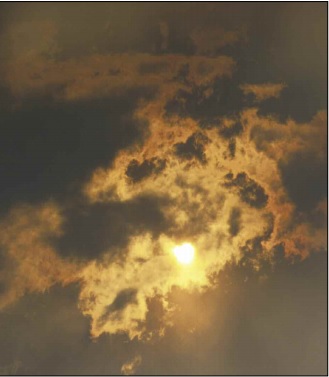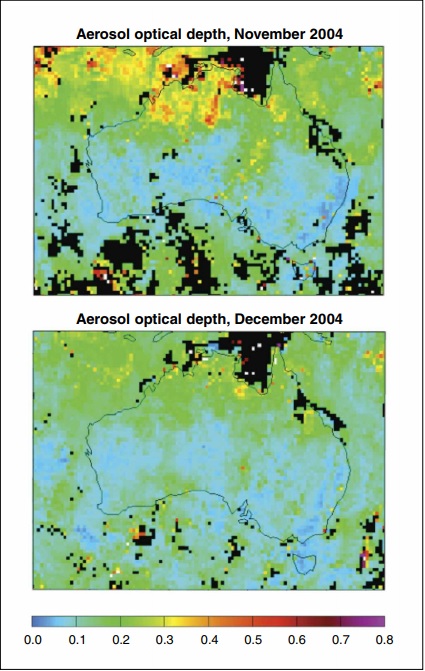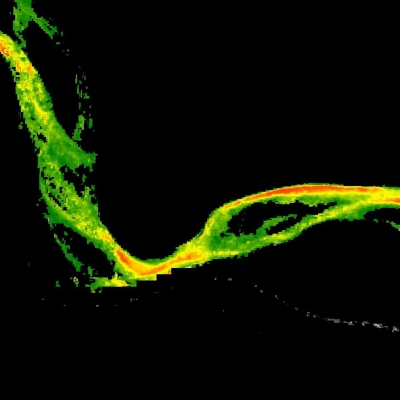Beachgoers in Darwin, Australia, have given up their bikinis and bare chests. Instead, they shield their skin from the blistering sun with long-sleeved shirts and hide their faces under floppy hats. Ultraviolet (UV) radiation in Australia is so intense that on a sunny day, a fair-skinned person can get a sunburn in less than fifteen minutes.
Australia’s unusually harsh sunshine results mainly from its location in the Southern Hemisphere. The elliptical orbit of the Earth places the Southern Hemisphere closer to the sun during its summer months than the Northern Hemisphere during its summer. This means that the summer sun in Australia is 7 to 10 percent stronger than similar latitudes in the Northern Hemisphere. Air currents high in the atmosphere sometimes bring ozone-depleted air from Antarctica’s ozone hole to Australia, letting even more UV through. And Australia’s sunny weather and relatively pollution-free air provide little additional protection from harmful UV rays.
With the highest skin cancer rates in the world, Australians have reason to pay attention to the factors that modulate UV light, such as cloud cover, ozone, and aerosols. Australians have already experienced an increase in sun intensity from ozone depletion, resulting from human-generated emissions of chlorofluorocarbons. Scientists are concerned that climate change could have further effects on UV radiation levels by changing the amounts of aerosols suspended in the atmosphere. Dust, smoke, pollution, and other small particles can scatter solar radiation back into space, decreasing the sun’s intensity. But in certain situations, they can also increase UV levels. Aerosols absorb solar and thermal radiation, contributing to warmer temperatures and climate change. Scientists are not sure which of these processes wins, because they know little about how UV and aerosols interact. To sort this out, a group of scientists from Australia and the United States decided to study how aerosols affect UV radiation.
Aerosol interactions
Frank Mills, a research scientist at the Australian National University, moved to Australia from California five years ago with the goal of exploring the relationship between climate change, aerosols, and UV radiation. Other researchers have suggested that climate change may lead to warmer, dryer weather that could increase smoke and dust aerosols. Mills wondered how changing aerosol levels would affect UV rays and whether aerosol type would make a difference.
An atmospheric physicist, Mills saw the lack of information on the interactions between aerosols and UV as a snarl of connections waiting to be untangled. “Climate change is likely to induce changes in cloud cover, aerosol abundance, and wind patterns, and these changes could have effects on surface UV levels,” Mills said. “But there hasn’t been any research as to whether that’s true or not.”
Mills decided to start with a basic question: how do different aerosol types affect UV radiation? From his previous work, Mills knew that a variety of data on aerosols was available. But finding accurate UV data would be more difficult. “At the time that I came to Australia, the UV data that existed were of sporadic quality and limited geographic range,” Mills said. Then in 2004, the Australian Bureau of Meteorology set up full-spectrum UV monitoring stations at Darwin, on Australia’s northern coast, and Alice Springs, a desert town 1,500 kilometers (932 miles) south of Darwin.
With the UV data gap filled, Mills needed a dust and smoke expert. He recruited research scientist Olga Kalashnikova from NASA's Jet Propulsion Laboratory (JPL) in Pasadena, California. Kalashnikova had helped develop a way to separate dust from other aerosol types using the Multi-Angle Imaging Spectroradiometer (MISR) instrument on the NASA Terra satellite. The idea of connecting aerosol properties with variations in UV radiation intrigued her, because she wanted to know how aerosols could affect climate. But knowing that aerosols come in many shapes and sizes, Kalashnikova also knew that different aerosol types have very different effects on sunlight. Understanding those wavelength-dependent differences was crucial for studying climate change.
Effects on UV light
Previous studies had shown that some aerosols, such as the pollutants that linger over big cities, reduce the UV reaching the ground, absorbing it or scattering it back into space. But aerosols include a diverse collection of materials, including a variety of airborne particles from the gases and particulate matter in pollution to natural dusts and smoke from wildfires. Each of those particles has different properties. So Mills and Kalashnikova planned to explore how different aerosol types affect solar radiation, using MISR aerosol data from NASA's Atmospheric Science Data Center (ASDC), together with the Australian UV measurements.
Serendipitously, the two sites the Australian Bureau of Meteorology chose for their measurements were home to completely different aerosol conditions. Darwin, on Australia’s northern coast, is occasionally blanketed in smoke from nearby wildfires. Alice Springs experiences periodic dust storms, which turn the sky a hazy orange. The different aerosol conditions provided a natural laboratory in which to compare the UV effects of dust and smoke.
The aerosol conditions at Darwin and Alice Springs were also well suited to satellite study, since MISR could differentiate between dust and non-dust aerosols. Kalashnikova said, “Unlike other satellites, MISR can see the way light scatters from many different angles.” This unique capability meant that MISR could measure not only aerosol depth, but also determine what type of aerosol was present from the particle shape. Most aerosol particles, including smoke, are spherical. But mineral dusts, essentially minuscule pieces of rock, have an irregular shape. By examining the way that an aerosol layer scatters multiple beams of light, Kalashnikova used the MISR sensors to determine whether those layers are made up of chunky, irregular dust particles, or smooth, spherical smoke. And this allowed her to compare how each aerosol type affected sunlight.
Smoke in the skies
Mills and Kalashnikova first examined smoke effects on UV. They identified wildfires using thermal anomaly data from the NASA Moderate Resolution Imaging Spectroradiometer (MODIS), and identified the smokiest days using MODIS aerosol optical depth measurements. Then they compared UV measurements from the clearest and haziest days in Darwin over the yearlong study period, finding that dense smoke coverage reduced the amount of UV light reaching the ground by as much as 50 percent.
However, the effect depended on wavelength. The UV radiation that reaches the Earth contains wavelengths just shorter than the visible spectrum of light, and is classified into UV-A and UV-B. Lower-energy UV-A has a longer wavelength, while higher-energy UV-B has a shorter wavelength. In Darwin, smoke aerosols reduced UV-B radiation as much as 40 to 50 percent on the smokiest days. The same amount of smoke reduced UV-A only 20 to 25 percent. While the team had expected that UV-A effects would be smaller, they were surprised at the magnitude of the difference.
Kalashnikova said, “It’s very important to know how different wavelengths are affected.” UV-B light is responsible for sunburns and is linked to the development of certain skin cancers. Longer wavelength UV-A penetrates further into the skin and can damage collagen, connective tissue that provides skin with structure and elasticity.
Next, Mills and Kalashnikova hoped to compare their smoke results to dust events over the Australian desert. However, in Alice Springs, the team encountered a problem. “We couldn’t find any good dust events,” Kalashnikova said. Using MISR, Kalashnikova had searched for plumes of aerosols that had dust-like scattering properties, but even with a year of data to draw from, they found only a few days showing moderate dust storms over Alice Springs.
“A big part of Australia is covered by desert,” Kalashnikova said. “In theory you would expect a lot of dust there.” But even though the deserts around Alice Springs spewed up the occasional dust storm, very little dust reached their study site. “In our study, not much dust was transported outside of smaller dusty regions,” Kalashnikova said.
The dearth of dust storms proved a setback in comparing the two aerosol types, but Kalashnikova said that it was a fascinating finding in itself. “It’s interesting because Australia was thought to produce a lot of dust,” she said. However, the study showed that, unlike Africa, where huge desert storms regularly send plumes of mineral dust thousands of miles across the Atlantic Ocean, Australian dust storms may often be confined to smaller areas.
Even without major dust events to draw from, the Alice Springs data suggested that dust aerosols were not as opaque to UV as smoke was. Kalashnikova said she hopes to repeat the experiment in a dustier location.
A global interest
Australia’s unusually strong sunlight has created a national interest in exploring the factors that affect UV radiation. Mills said, “Interest on UV radiation levels within Australia is driven primarily by health concerns.”
But while Australian health officials worry that climate change might increase UV radiation and skin cancer risk, scientists note that the same factors that could lead to changes in UV may also affect the climate. Increased aerosols may contribute to a feedback cycle that increases warming, or they might lead to a negative feedback cycle that dampens warming. Such changes could have broad implications for people and the environment. However, before scientists can incorporate those factors into climate models, they need to understand how aerosols interact with the environment.
Scientists must understand not just aerosol amount, but also aerosol type and how aerosols affect different wavelengths of light. Kalashnikova said, “We need to understand every part of the spectrum, from UV to infrared. Atmospheric studies show that aerosols have a very big effect on the climate, but that effect is not well understood.”
Although it is well accepted that aerosols have an overall cooling effect on the environment, climate scientists still do not understand how changes in total aerosol amount and properties affect the climate on local and global scales. Observing the interplay between UV radiation and aerosols may help scientists tease out the connections and better understand one aspect of the tangled interactions that link climate, dust, smoke, and UV.
References
Kalashnikova, O. V., F. P. Mills, A. Eldering, and D. Anderson. 2007. Application of satellite and ground-based data to investigate the UV radiative effects of Australian aerosols. Remote Sensing of the Environment 107: 65–80, doi:10.1016/j.rse.2006.07.025.
Madronich, S., R. L. McKenzie, L. O. Björn, and M. M. Caldwell. 1998. Changes in biologically active ultraviolet radiation reaching the Earth’s surface. Journal of Photochemistry and Photobiology 46: 5–19.
For more information
NASA Atmospheric Science Data Center (ASDC)
Moderate Resolution Imaging Spectroradiometer (MODIS)
Multi-Angle Imaging Spectroradiometer (MISR)
| About the remote sensing data | |||
|---|---|---|---|
| Satellites | Terra | Terra and Aqua | Terra and Aqua |
| Sensors | Multi-Angle Imaging Spectroradiometer (MISR) | Moderate Resolution Imaging Spectroradiometer (MODIS) |
MODIS |
| Data sets | Monthly Average AOD (558 nm green band) and Angstrom parameter (446-867 nm) | Level 2 fire products (fire mask) | Level 2 aerosol (AOD) |
| Resolution | 380 kilometer | 1 kilometer | 1 kilometer |
| Parameters | Aerosols | Thermal anomalies/fire products | Aerosol optical depth |
| DAACs | NASA Atmospheric Science Resource Center (ASDC) | NASA Land Processes Distributed Active Archive Center (LP DAAC) | NASA Level-1 and Atmosphere Archive and Distribution System DAAC (LAADS DAAC) |


